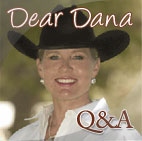Head Toss
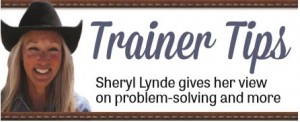 Head tossing, like any behavior, ranges in degrees of severity. One level may merely cause frustration while the next can prove to be dangerous to the owner with risk of injury.
Head tossing, like any behavior, ranges in degrees of severity. One level may merely cause frustration while the next can prove to be dangerous to the owner with risk of injury.
A common habit many riders share is leaning too far forward. Instead of riding with their shoulders behind their hips, they ride with their shoulders hovering over the saddle horn. Then, if their horse tosses his head abruptly, the rider can get a rude awakening with a pretty good crack on the skull.
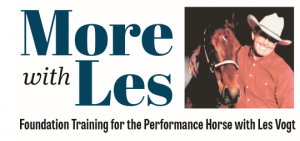 After last issue’s lesson on backing up, Les takes a moment now to remind why we don’t make a big deal about losing your horse’s attention.
After last issue’s lesson on backing up, Les takes a moment now to remind why we don’t make a big deal about losing your horse’s attention.
Sometimes when you’re riding you’re going to lose your horse’s attention. I say don’t make a big deal out of it. Some might not see as well as others, or may be more spooky, especially as far as young horses go, when they go off to the Bahamas every now and then; leave it alone and it goes away. Be patient.
Backing: From rein cue to active leg cue
41st in a Series
 After Les showed us turns on the forehand last issue, let’s go the opposite direction and back up.
After Les showed us turns on the forehand last issue, let’s go the opposite direction and back up.
Your goal when you back is to not have to pull back hard on the horse’s mouth to get him to move backward, but to be able to use just enough contact with the bit to tell him to not go forward—kind of like shifting him into reverse—and then using your legs, like the gas, to move backward. Yes, you might have to tug a little to get him started, but your goal is to take it from an active rein cue to an active leg cue as quickly as possible.
The timing of your command and correction, if it’s needed, is really important as well. You can’t say “whoa” and correct at the same time. You have to say “whoa,” wait for him to try, and then correct him if he doesn’t stop. In order for the horse to learn, you have to give him a chance to do it right. When he does give you an effort, make sure he knows it was the right one. He just made his first move toward a great sliding stop! Nothing you see in a reining class is done overnight; it’s done through years of consistent training, but the hardest part can be the consistency.
Canter too fast? Make the choice his
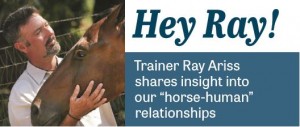 HEY RAY! How do you get a “chargey” Mustang to rate at the canter? Mine does everything well at the walk and trot, just not the canter. —Dennis Parker, Zamora, CA
HEY RAY! How do you get a “chargey” Mustang to rate at the canter? Mine does everything well at the walk and trot, just not the canter. —Dennis Parker, Zamora, CA
HEY DENNIS: The good news is you have 66 percent of your horse under control! I assume you didn’t have a stuck accelerator issue with the other two gaits. If you did, I would simply advise you to use the same approach and technique for the canter. The simplest way to get your horse to understand that racing at the canter is something he can do—but not necessarily a good idea— is to allow him to lunge around you at whatever speed he chooses until he slows down. The keys here are:
A. Be sure you don’t encourage or motivate him to move in any way unless he breaks out of the gait. (This means hands down, quiet and little-or-no foot movement at all.)
B. If and when he breaks, remember to jump start him back into the canter assertively and then back off immediately to a passive state on your part.
Easiest way to break bad habits: Create a new one!
 As you improve your horsemanship skills, there will be habits that need breaking. The easiest way to change one pattern of behavior is to replace it with a new one. When a horse spooks or threatens to bolt or buck, the safest way to keep yourself and your horse safe is to use one rein and bring your Horse’s nose to your toe and disengage his hips. If you have practiced disengaging hips safely at home at all gaits, you and your horse will be better prepared to manage unforeseen situations that arise away from home. However, for many people their first impulse is to tighten up on both reins and pull. They feel a sense of security by pulling on both reins at once, but by doing so, this pulls the rider forward lifting their seat out of the saddle causing their legs to extend behind their body close to the horse’s flanks. When they become unseated, they clamp on with their legs and if they are wearing spurs, this can escalate into a more dangerous situation in a hurry.
As you improve your horsemanship skills, there will be habits that need breaking. The easiest way to change one pattern of behavior is to replace it with a new one. When a horse spooks or threatens to bolt or buck, the safest way to keep yourself and your horse safe is to use one rein and bring your Horse’s nose to your toe and disengage his hips. If you have practiced disengaging hips safely at home at all gaits, you and your horse will be better prepared to manage unforeseen situations that arise away from home. However, for many people their first impulse is to tighten up on both reins and pull. They feel a sense of security by pulling on both reins at once, but by doing so, this pulls the rider forward lifting their seat out of the saddle causing their legs to extend behind their body close to the horse’s flanks. When they become unseated, they clamp on with their legs and if they are wearing spurs, this can escalate into a more dangerous situation in a hurry.
Why hip control is so important
 Having control of the horse’s hips will prove to be quite critical for almost all of your reining maneuvers. You’ll need it for departures, lead changes and turnarounds particularly. Since many of the body control exercises that we’ll be working on in the next level will require you to have some hip control, you need to get started on it early in the program.
Having control of the horse’s hips will prove to be quite critical for almost all of your reining maneuvers. You’ll need it for departures, lead changes and turnarounds particularly. Since many of the body control exercises that we’ll be working on in the next level will require you to have some hip control, you need to get started on it early in the program.
Point to Remember:
On this and most other things, you teach your horse. We’ll never be strong enough to make a horse do anything, but we can be smart enough to make him want to do it, and that’s what riding is all about.
 Last issue, Les demonstrated use of a light brace rein to keep shoulders out of the way. Now, let’s work on turns on the forehand.
Last issue, Les demonstrated use of a light brace rein to keep shoulders out of the way. Now, let’s work on turns on the forehand.
Start by walking along the fence. Pick a point to stop the horse and then make a very light contact with your inside (away from the fence) rein while you reach back with your fence-side leg and push or bump your horse’s hip around. You’re creating energy with your leg to push the hip, and your brace rein contact will lightly block him from pushing through with his shoulder. With the fence in front of him you don’t give your horse any other options but to move his hip. Do this exercise repeatedly (it’s called a turn on the forehand) both directions. Start by just asking for a step at a time and then increase the number of steps as your horse’s responses get more consistent. Remember to keep life in your reins and leg as you ask for this exercise.
Get Your Head in the Game
 Training takes time. There is no shortcut to having an ability to accurately respond to — and correct — a horse’s behavior in a way that progresses their training. So, if it takes time for the rider, it also takes time for your horse to put together the skills you are asking him to perform.
Training takes time. There is no shortcut to having an ability to accurately respond to — and correct — a horse’s behavior in a way that progresses their training. So, if it takes time for the rider, it also takes time for your horse to put together the skills you are asking him to perform.
How do you learn? By making mistakes, correcting those mistakes, and moving on. Making mistakes is the name of the game, and you will make many. Each mistake will shape you, strengthen you and teach you. If you’re not making mistakes, you’re not learning.
Exercise 3: Body control on the fence
39th in a series
Last issue, Les started Exercise 3 with highlights on the brace rein and ribcage control. Now we’ll go to work.
Exercise number three is basically sidepassing, but it will have one big difference for most of you. While most novice riders start sidepassing by moving the shoulders and catching up with the hips, I’m not going to let you do it that way. Letting a horse lead with his shoulders creates such a disaster when it comes to lead changes that we simply never let them lead with their shoulders when we use our leg in the middle, or the back, position. We are always using a light brace rein to keep their shoulders out of the way, or at least neutral.
Freedom of choice is key to your horse’s happiness—and reactions
 HEY RAY! This is about lost trust and resentment. I was training my horse, Connor, for trailering. Whenever he stopped in front of the trailer, I would back him up forcefully—I was trying to make the choice of either going “forward” or being “backed up forcefully.” I had thought of “backing up” as punishment. At that time, I didn’t know about SWAP and didn’t reward him for successfully backing up. Not only that, I backed him up very forcefully. If I caught up to him while I was running forward, he would get a sharp tap in the chest. Now he is resentful. How do I get him back? —Evan Moser, Lancaster, Calif.
HEY RAY! This is about lost trust and resentment. I was training my horse, Connor, for trailering. Whenever he stopped in front of the trailer, I would back him up forcefully—I was trying to make the choice of either going “forward” or being “backed up forcefully.” I had thought of “backing up” as punishment. At that time, I didn’t know about SWAP and didn’t reward him for successfully backing up. Not only that, I backed him up very forcefully. If I caught up to him while I was running forward, he would get a sharp tap in the chest. Now he is resentful. How do I get him back? —Evan Moser, Lancaster, Calif.


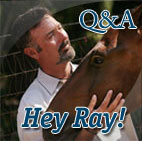
 Read Columns
Read Columns
